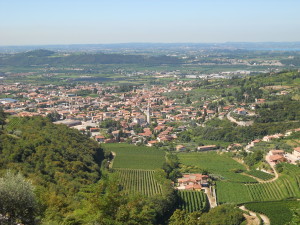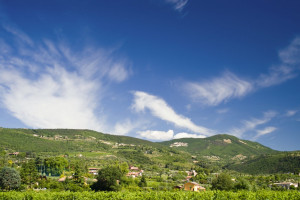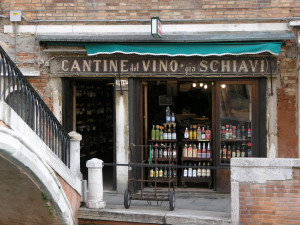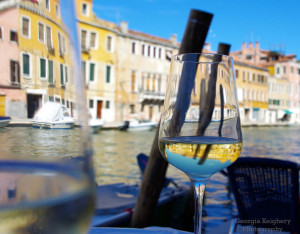Romantic Veneto
The wines found in Venice are as misunderstood by most travellers as the city’s cuisine – which is probably why we see more Sicilian Chardonnays than Veneto Soaves on restaurant tables.
Of course wine isn’t produced in Venice itself – although there are grapes grown on the lagoon’s islands. Venice’s ‘local’ wine comes from around the region, so in keeping with our romantic travel theme we decided to learn more about wines from the Veneto, and who better to teach us than some locals?
A Basic Introduction
 The most famous Veneto wines come from the towns of the same name: Soave, Valpolicella and Amarone. Soave tends to be a fresh, light, dry white wine, although of course we can find delicious medium-bodied Soaves too, Valpolicella is a fairly light, easy-to-drink red which tastes of young cherries and pepper, while Amarone is a fuller red with flavours of plum, dried figs and very ripe cherries that is typical of over-matured wines. Soave is made for fresh seafood, Valpolicella is great with many pastas, while Amarone – well, legend has it that it was created to drink with horsemeat stew! You know they used to call the people of Vicenza ‘cat-eaters’! – is great with meatier main courses and cheeses.
The most famous Veneto wines come from the towns of the same name: Soave, Valpolicella and Amarone. Soave tends to be a fresh, light, dry white wine, although of course we can find delicious medium-bodied Soaves too, Valpolicella is a fairly light, easy-to-drink red which tastes of young cherries and pepper, while Amarone is a fuller red with flavours of plum, dried figs and very ripe cherries that is typical of over-matured wines. Soave is made for fresh seafood, Valpolicella is great with many pastas, while Amarone – well, legend has it that it was created to drink with horsemeat stew! You know they used to call the people of Vicenza ‘cat-eaters’! – is great with meatier main courses and cheeses.
Veneto Wines in Context
We’ll begin with the quintessential Veneto wine, Prosecco. Prosecco is really a pre-meal drink although it can go with anything – a bit like Cava. Prosecco is important culturally, when getting together with friends, business contacts, and family! A glass before lunch and before dinner is considered one ritual most people from the Veneto would never give up!
Next you should try another sparkling white, Durello, from the hills of Vicenza, which is left to distil longer than Prosecco and so has more of a bouquet; then a Soave Superior (‘Superior’ means it has more alcohol), and finally a still Durello, from those same hills near Vicenza. This time it’s an organic wine (which we discovered was very fashionable in Paris), which has that clarity and purity that’s so desirable in organic wines.
For your tasting of Veneto reds we recommend you to go to a new bar, the very charming and very local Ostaria Al Ponte, where the waitress delivers an interesting platter of Venetian snacks, including the artichoke that’s in season, Asiago cheese, tuna in tomato and peperoni.
 You should begin with a boutique wine called ‘A Mi Manera’ (My Way) made from Cabernet Merlot and Franconia, followed by a Valpolicella ‘Superiore’ (in the case of Valpolicella it has just 1% more alcohol, Rachel explains, while ‘Classico’ means it’s made in an older part of an area and is more traditional, and ‘Reserva’ is the very oldest), and finally a Fragolino made from strawberries. All are delish!
You should begin with a boutique wine called ‘A Mi Manera’ (My Way) made from Cabernet Merlot and Franconia, followed by a Valpolicella ‘Superiore’ (in the case of Valpolicella it has just 1% more alcohol, Rachel explains, while ‘Classico’ means it’s made in an older part of an area and is more traditional, and ‘Reserva’ is the very oldest), and finally a Fragolino made from strawberries. All are delish!
If there’s one wine people shouldn’t leave Venice without trying, what would it be? “Prosecco absolutely!” we can assure you. As well as Cartizze, a more sophisticated version of Prosecco, made with grapes that come from just one particular hill in that growing area… and (of course) Amarone, which is really one of Italy’s top red wines, up there with Barolo and the Brunello. That’s three, but whose counting?
SO…
What makes Veneto wines special?
The variety of our terrain, climate and grapes, all in a region just under 20,000 km sq. The terroir (terrain and climate) is extremely important. Here in the Veneto we have distinct wine-producing areas such as the Valpolicella valley (home to Amarone), the gentle rolling countryside of Verona (Soave), the Berici hills near Vicenza, the area around Lake Garda (Bianco di Custoza), the green hills in the northeast surrounding Valdobiaddene and Conegliano (of Prosecco and Cartizze production), just to name a few! There are a wide variety of grapes that do well here, from local ones (corvina, molinara, rondinella, pr osecco, friularo, etc) to international grapes like cabernet franc, cabernet sauvignon, and merlot (which actually makes up 30% of all grapes grown), which result in a vast assortment of quality wines.
osecco, friularo, etc) to international grapes like cabernet franc, cabernet sauvignon, and merlot (which actually makes up 30% of all grapes grown), which result in a vast assortment of quality wines.
Characteristics that distinguish Veneto wines? Wines to look for?
Firstly, the variety of wines! For red wine lovers, the Veneto has young reds, meant to be drunk within a year or two from production, such as Valpolicella, Bardolino, Marzemino and Merlot, and the more robust and complex reds such as the Amarone, and Bordeaux blends from the Colli Euganei, such as Gemola and Arquà, from the producer Vignalta in Arquà Petrarca, which is really head and shoulders above the rest in this area. White wine-lovers should try Prosecco and Cartizze (both sparkling) and for still whites, Soave, Lugana, Bianco di Custoza, and Vespaiolo.
Best places in Venice to try and buy wine?
Mai Tardi Enobar in Cannaregio, on the main street between Campo Santi Apostoli and the Rialto – there are tables outside and the staff are very knowlegeable and friendly, and they have an excellent selection of wines and fantastic quality cheeses – as well as Osteria Al Ponte, on the border of Cannaregio and Castello, at the foot of Ponte Gallina (it has red doors and window frames), which is one of the oldest bars in Venice, and has great salumi and cold seafood dishes, as well as great wine, plus helpful staff, and a mostly local clientele. Also Al Vecia Carbonera, on the Strada Nova in Cannaregio, which has an excellent selection of wines and cicchetti. You can also buy wine at these bars at reasonable prices.
Best wine to buy?
A great Amarone. The difference in price makes this worthwhile.
Matching Venetia n Food and Wine
n Food and Wine
For many visitors to Venice, who are unfamiliar with the city’s unique cuisine, choosing the right wine can be a challenge. We asked Rachel for some tips on pairing Venetian food and wine.
Starters
Begin a meal with Prosecco on its own, although it can be paired with any cicchetti. It’s nice with the local baccalà mantecato (a cod spread) on polenta and young fatty cheeses like Asiago.
Pasta and Mains
Other still whites like Soave, Lugana, Bianco di Custoza go well with other fish appetizers or seafood dishes in general. They won’t overpower a subtle grilled white fish like Cernia, orata or branzino, which Venetians prefer simply prepared. A Vespaiolo goes well particularly with egg and asparagus, or for example fresh tagliatelle with asparagus and shrimp. My mouth is watering!
Dessert
Dessert pairings are easy. You need a sweet wine with a sweet dish, so this is one place where Prosecco would be out of place. We have lovely sweet wines that are never overly so, or cloying, such as Recioto di Valpolicella: a sweet red wine that’s great with simple dry pastries or cookies (dipping allowed!). Recioto di Gambellara, a recent DOCG-labelled sweet white from the area near Vicenza, is great with creamy desserts like pannacotta, creme caramel, and torta alle mandorle, while Recioto di Soave, another sweet white wine, is good with fruit desserts, crostate, etc. If you have a very heavy dessert, a light sparkling wine such as Fior D’Arancio, a moscato bianco o giallo, from the Colli Euganei is a good match.



 0
0